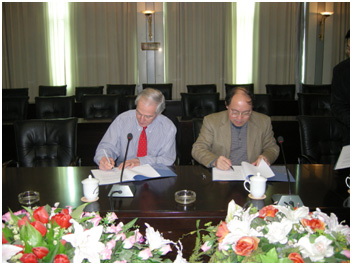Natcore Signs Agreement with Chinese Consortium to Take its Solar Technology From Lab to Power Grid

RED BANK, NJ – February 22, 2010 – Natcore Technology Inc. (TSX-V: NXT; NTCXF.PK) has reached agreement with a consortium in China to form a joint venture company to develop and manufacture film-growth equipment and materials using Natcore’s proprietary Liquid Phase Deposition (LPD) technology.
Natcore has signed a letter of intent with the Zhuzhou Hi-Tech Industrial Development Zone (“Hi-Tech Zone”) to form a new company, Natcore China, with rights to manufacture anti-reflective (AR) film growth equip ment and materials. Natcore China will be 55% owned by Natcore Technology, with the Hi-Tech Zone and its partners (“Chinese Partnership”) holding the remaining 45% ownership position.
“This is a major milestone in the growth of Natcore Technology,” notes President and CEO Chuck Provini. “Not only does it fully fund our remaining research, development and production costs for AR film equipment, but it immediately plugs us into a network of end users in a country that is one of the world’s largest and fastest-growing producers of solar cells. It helps move us out of the lab and closer to achieving our goal of making solar energy efficient enough to be affordable to the world.
Natcore China will be funded by an initial $3 million investment consisting of $500,000 contributed by Natcore Technology, and $2,500,000 contributed by the Chinese Partnership. (All amounts in U.S. dollars.) Natcore China will have the exclusive right to develop, manufacture and sell AR film-growth equipment in China, and a three-year exclusive right to manufacture such equipment for sale outside of China. Natcore Technology and the Chinese Partnership have begun drafting a definitive agreement incorporating the principles reflected in the executed letter of intent. Completion of the agreements is subject to regulatory approval.
The Chinese Partnership will consist of the Zhuzhou Hi-Tech Industrial Development Zone and two Chinese firms, including a major producer of polysilicon and a manufacturer of industrial equipment used in the solar industry. Natcore’s partners project that the joint venture company will eventually create as many as 500 jobs in manufacturing and R&D.
Key elements of the joint venture include:
- Majority 55% control of the joint venture by Natcore Technology.
- Operation in China as a local company, with all intellectual property protections accruing to such a position.
- Natcore Technology funds 17% of joint venture; with the Chinese Partnership contributing 83%.
- A fast-track development program initiated upon signing of a definitive agreement, with a projected timeline of 10 months to first product shipments.
- Early integration of Natcore’s LPD film-growth technology into existing solar cell production lines, in advance of final equipment development.
- The ability to fast-track revenues by accepting lead orders in China and throughout the world.
“We had always envisioned a joint venture operation in China as part of our long-term business plan, after we had completed development of our AR film growth equipment.” notes Brien Lundin, Natcore’s Chairman and co-founder. “But well before that could come to pass, we were approached by the Hi-Tech Zone with their offer to completely fund our AR film growth development program, and give us majority ownership in the joint venture.”
“We will retain control, enjoy a ready-made customer network and open up new avenues for funding of potential future joint ventures,” he adds. “It was an opportunity we couldn’t refuse.”
Under the agreement, Natcore China will complete the engineering and production of self-contained, self-replenishing film-growth equipment that will recycle the chemicals and water used in Natcore’s LPD process. In advance of this, however, the Chinese Partnership envisions the incorporation of the technology into existing manufacturing lines through manual replenishment of the chemical bath. In this way, Natcore China would be able to serve its first customers, which may include members of the Chinese Partnership, before final product development is completed.
One of the key advantages of the Natcore LPD process is its relatively low environmental impact. “Pollution control and toxicity are very big issues in China now,” says Provini. “Our ability to not only reduce the cost of solar cell manufacturing, but to also do so in a much more environmentally friendly manner, is a very important benefit to our new partners and their customers.”
Natcore Technology © All rights reserved. Sitemap ![]()

Comments are closed.